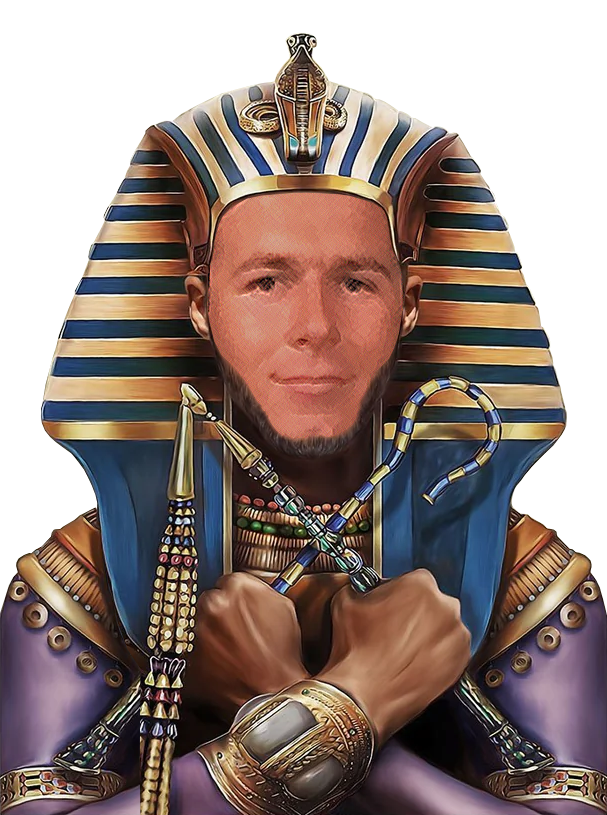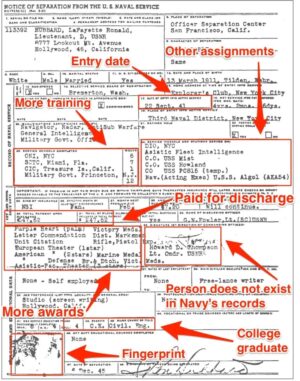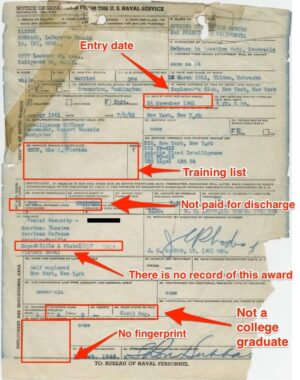 Ha ha … just kidding. At first, you thought that read Douglas MacArthur, who served as a career Army officer for the majority of his life. MacArthur, one of the few individuals to achieve a five-star rank, notably served in World War I, World War II, and the Korean War.
Ha ha … just kidding. At first, you thought that read Douglas MacArthur, who served as a career Army officer for the majority of his life. MacArthur, one of the few individuals to achieve a five-star rank, notably served in World War I, World War II, and the Korean War.
To read the various biographies on Scientology websites about their founder’s military exploits, one would think they are reading about someone of General MacArthur’s importance, but the actual account of L. Ron Hubbard’s participation in World War II is nowhere near the larger-than-life figure who commanded the Southwest Pacific and became the most decorated American soldier of the war.
ONE OF TWO SHIPS HUBBARD
BRIEFLY COMMANDED DURING WWII
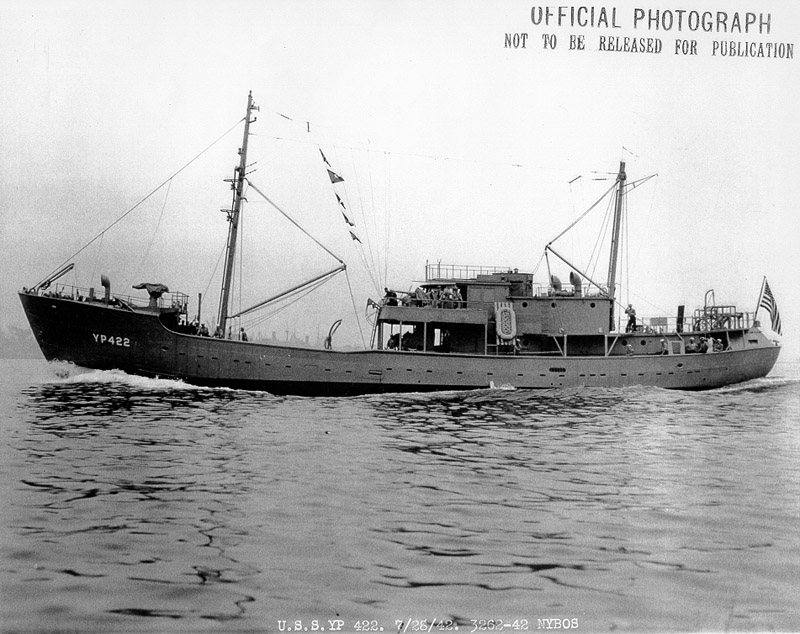
Hubbard’s vessel, the USS YP-422, was neither a corvette nor a subchaser but a converted trawler, responsible for patrolling coastal waters rather than escorting convoys across the North Atlantic. Although a trawler may seem an unlikely warship, its presence in the US Navy was necessitated by the desperate situation in which the Navy found itself in the early days of World War 2. Records regarding this deployment are documented here.
LARGER-THAN-LIFE IS WHAT SCIENTOLOGY
WOULD LIKE YOU TO THINK
OF NAVAL LIEUTENANT L. RON HUBBARD!
The Wikipedia page on Hubbard’s military career provides the proper perspective on this examination and thankfully, Scientology’s editing permissions were removed in 2009 “saying that it [Scientology] has changed copy to advance its own agenda.”
As with many other aspects of L. Ron Hubbard’s life, accounts of his military career are much disputed. His account of his military service later formed a major element of his public persona, as depicted by his Scientologist followers. The Church of Scientology presents Hubbard as a “much-decorated war hero who commanded a corvette and during hostilities was crippled and wounded”. According to Scientology publications, he served as a “Commodore of Corvette squadrons” in “all five theaters of World War II” and was awarded “twenty-one medals and palms” for his service. He was “severely wounded and was taken crippled and blinded” to a military hospital, where he “worked his way back to fitness, strength and full perception in less than two years, using only what he knew and could determine about Man and his relationship to the universe.”
However, his official Navy service records indicate that “his military performance was, at times, substandard”, that he was only awarded a handful of campaign medals, and that he was never injured or wounded in combat and was never awarded a Purple Heart. Most of his military service was spent ashore in the continental United States on administrative or training duties. He briefly commanded two anti-submarine vessels, USS YP-422, and USS PC-815, in coastal waters off Massachusetts, Oregon, and California in 1942 and 1943 respectively. He was removed from command of both vessels and rated by his superiors as being unsuitable for independent duties and “lacking in the essential qualities of judgment, leadership, and cooperation”. Although Hubbard asserted that he had attacked and crippled or sunk two Japanese submarines off Oregon while in command of USS PC-815, his claim was rejected by the commander of the Northwest Sea Frontier after a subsequent investigation. He was hospitalized for the last seven months of his active service, not with injuries but with an acute duodenal ulcer.
The Church of Scientology rejects the official record and insists that Hubbard had a second set of records that the U.S. Navy has concealed.
INSERT LAUGH TRACK HERE…
The entire Wikipedia entry reads in stark contrast to the glowing Scientology videos and biography accounts of Hubbard’s military service with many paragraphs basically concluding “this [claim] has never been substantiated.”It is no stretch to believe that L. Ron Hubbard possessed enough fertile storytelling imagination to have become a reincarnated larger-than-life “Walter Mitty” hero of his mediocre career in the U.S. military.

Scientology’s hagiographers love to make an awful lot of their founder’s astonishing navy service. The fact is much less flattering. Hubbard’s own oral history includes exaggerations and fantastical lies, from claiming he sunk two Japanese subs and had sizable battle injuries, to his claims that his dabbling in intercourse magic with Jack Parsons used to be without a doubt a covert mission for the Navy. These lies are an affront to all veterans who absolutely “walked the walk” and gave lives and limbs to maintain our freedom.
The altar of faith Scientology has built is primarily based on the fallacy of this supposed top-notch man and his conflict heroism, insight, research, and his supposed awesome abilities. This obeisance is bankrupting households and tearing them apart, and despite all known evidence to the contrary, they continue to be tax-exempt … with much of their cash used to spy on and harass any opponent of the cult. This is a disgrace on the same level as any other “Stolen Valor.“
“Stolen Valor” is a term applied to the phenomenon of people falsely claiming military awards or medals they did not earn, service they did not perform, Prisoner of War experiences that never happened, and other tales of military actions that exist only in their minds.
Expert researcher Jeffrey Augustine created and operates the website The Scientology Money Project, an investigative website that examines Scientology money, legal matters, personalities, and crime. His work has been quoted by Forbes, Reuters, Fortune, The Daily Mail, The Sun, and many other online publications. He brings the goods … “Scientology Founder L. Ron Hubbard’s Fake Purple Hearts and Bronze Star!”
The Church of Scientology has long claimed that founder L. Ron Hubbard won two Purple Hearts, a Bronze Star, and 19 other combat medals in WWII. The fact is that L. Ron Hubbard never served one day in combat, never fought in combat, and was most certainly never wounded in combat.
Fact: L. Ron Hubbard worked as a self-employed typewriter jockey cranking out pulp fiction for a penny a word until he went on active duty US Navy on 22 Sept 1941. Then 32 years of age, Hubbard received a commission as a lieutenant jg and did not go through Officer’s Training School or any type of combat or weapons training. In particular, Hubbard had no amphibious warfare or jungle survival training. Hubbard’s first job on active duty was to review and annotate the hydrographic surveys of Puget Sound he had sent to the US Navy ten years earlier. Hubbard was not a combat soldier and had no special background training, no special skills, and only spoke English.
Despite Hubbard’s lack of qualifications or training in Intelligence, one of the Church of Scientology’s long-term propaganda projects has been to quietly perpetuate L. Ron Hubbard’s bogus claim that he was a secret agent with the Office of Naval Intelligence. The fact is L. Ron Hubbard was a low-level cable censor in the Department of Naval Intelligence for a few months and then served in various other assignments.
Hubbard bragged that he was once a top-flight naval officer in World War II, who commanded a squadron of naval ships, was wounded in battle, and was notably decorated for meritorious service.
But Navy and Veterans Administration files acquired via the federal Freedom of Information Act disclose that his Navy overall performance was, to be kind, substandard.
The Navy archives variously describe him as a “garrulous” man who “tries to provide impressions of his importance,” as being “not temperamentally outfitted for unbiased command” and as “lacking in the quintessential traits of judgment, management and cooperation. He acts without forethought as to likely results.”
Ron The War Hero: The True Story of L Ron Hubbard’s Calamitous Military Career.
By Chris Owen.
RON THE “WAR HERO”
L. RON HUBBARD AND THE U.S. NAVY, 1941-50
1: Introduction:
The Church of Scientology is, rightly, critical of those who comment on its activities on the basis of conjecture or undocumented statements. It is only right and proper that its own statements about L. Ron Hubbard should be subjected to similar scrutiny. The only agenda prompting the production of this account is the desire to discover the truth about Hubbard’s war years – a truth which, it turns out, is more complicated than is usually portrayed either by the Scientologists or their harsher critics.
2: L. Ron Hubbard: his struggle with the truth
Hubbard ended the war (in 1944 or, alternatively, 1945) crippled and blinded after an unexploded shell, which had landed on the deck of his ship and which he was throwing overboard, exploded in his face (letter to Hubbard family, quoted by L. Ron Hubbard Jr. in the letter of 26 January 1973). Alternatively, he had suffered flash-burn injuries to his eyes while serving as Gunnery Officer aboard the USS Edsall earlier in the war, resulting in him being declared “legally blind” (Church of Scientology v. Armstrong, 21 May 1984; also “Ron – Letters and Journals”, 1997). Yet another alternative is that he had been left lame by shrapnel fragments in his hip and back (“Ron – Letters and Journals”, 1997). He was taken to Oak Knoll Naval Hospital in California where he was treated for injured optic nerves and physical injuries to his hip and back. He was officially assessed as having “no neurotic or psychotic tendencies of any kind whatsoever” (Hubbard, “My Philosophy”, 1965).
Confused? The Church of Scientology certainly is. This improbable and contradictory account was assembled from no less than twenty-seven different sources, twenty-four of which were published by the Church of Scientology itself. Scientology’s own websites present at least three different versions of Hubbard’s service career.
As this shows, Hubbard’s followers have been chronically unable to present a coherent picture of what exactly he did in the war. This is remarkable, since every official account credits Hubbard’s experiences in the war as being the catalyst for the development of his “science of the mind”. Considering the fundamental importance of this period to Scientology’s origins, it is most peculiar that the organization which Hubbard founded has been unable to settle on a consistent account.
3.1: The Navy’s View
The Navy has never changed its story over Hubbard’s career; nearly identical versions of this summary have been issued on request for at least fourteen years (though there are a few minor corrections between the first and the current versions). This is, of course, in marked contrast to the ever-shifting Scientology accounts.
3.2: Joining Up
Despite being the son of a Naval officer, the US Navy was not Hubbard’s first port of call as war loomed in Europe. At the start of the 1930s, he joined the US Marine Corps. On May 1, 1930, he enlisted with the 20th Marine Corps Reserve, a Reserve training unit connected to George Washington University in Washington, D.C. His duties were light in the extreme: on the day that he joined, he was transferred to an inactive state and over the next 18 months performed only about five weeks of active duty (all for training). On October 22, 1931, Hubbard received an honorable discharge from the Marine Reserve. In another hand beneath this is written, “Not to be re-enlisted.” There is no explanation for either statement. It did, however, have the effect of permanently debarring Hubbard from further service with the USMC. There is no record of him trying to enlist again.
3.3: Naval Intelligence
This officer is not satisfactory for independent duty assignment. He is garrulous and tries to give impressions of his importance. He also seems to think that he has unusual ability in most lines.
– US Naval Attaché to Australia, February 14, 1942
3.4: War in the Atlantic, the USS YP-422
He is not temperamentally fitted for independent command.
~ signal from Commandant, Boston Naval Yard (Sept 25, 1942)
3.5: War in the Pacific, the PC-815
L. Ron Hubbard’s second and last command was aboard the USS PC-815, a Pacific Ocean subchaser. His career aboard lasted just 80 days; its disastrous conclusion ruined any chance Hubbard might have had of commanding another warship.
3.6: The Battle of Cape Lookout
It is specifically claimed that one submarine, presumably Japanese, possibly a mine-layer, was damaged beyond the ability to leave the scene and that one submarine, presumably Japanese, possibly a mine-layer, was damaged beyond the ability to return to its base.
– L. Ron Hubbard, action report (May 24, 1943)
In Hubbard’s case, no vessel is recorded by either the British or American naval authorities as having been sunk off the West Coast of the United States at any time during the war. Almost every Japanese submarine was accounted for. Of the 130 Japanese submarines destroyed during World War II, the cause of destruction of only five was never determined, and of those, the location of only one remained unknown. The files of the Imperial Japanese Navy also revealed that no submarines had been present off Oregon and only one submarine had lost in the whole of May 1943 – the RO.137, sunk by the USS SC-669 in the New Hebrides.
A final piece of evidence is perhaps the most direct of all. If one, or possibly two, Japanese submarines, were sunk by Hubbard, where are they? Presumably still on the sea bed. However, no wrecked Japanese submarines have been reported off the US West Coast. People have certainly looked for them – including the Church of Scientology, which is reported to have mounted a costly expedition in the early 1980s. But nobody has ever found them. Hubbard’s submarines, in fact, seem remarkably elusive. Certainly, nobody has been able to identify which they were or where they presently lie.
This officer [is] lacking in the essential qualities of judgment, leadership, and cooperation. He acts without forethought as to probable results.
– Rear Admiral F.A. Braisted, July 15, 1943
L. Ron Hubbard, the former Naval Captain who went on to start the Church of Scientology, ordered the shelling of the Coronados Islands on June 28, 1943. The problem is, the islands weren’t—and aren’t—part of the United States. They’re part of Mexico.
Hubbard was the Captain of PC-815, a 170-foot submarine chaser, and was ordered to conduct maneuvers in the waters off of San Diego. After the exercises were completed, Hubbard unwittingly ordered the PC-815 to enter Mexican waters and anchor off the southernmost of the craggy Mexican islands.
According to an investigative board convened two days later, “An undetermined number of splashes were observed in the water in the direction of land during the firing.” The board also noted, “Evidence of shells hitting land or rocks on the Northern end of South Coronados Island was observed on two separate instances during the firing.”
3.8: “Mister Roberts” and the USS Algol
Almost as soon as Hubbard was relieved of commanding the USS PC-815, he reported sick. On July 15, 1943 – the same day as Rear Admiral F.A. Braisted had sent a letter of admonition concerning the unfortunate shelling of Mexico’s Coronado Islands – Hubbard was put on the sick list in San Diego after complaining of a variety of problems, ranging from epigastric pains to back pains to malaria. According to a doctor’s report, Hubbard claimed to have suffered a previous bout of malaria sixteen months earlier in a “combat area”. In January 1942, he had been in southern Australia – hardly a war zone – and had not been diagnosed with malaria then or thereafter; no diagnosis of malaria appears anywhere in his extensive medical files. In his private papers, he admitted that his claims of illness were prompted not by genuine symptoms but by a desire to avoid disciplinary action. He wrote home to inform the family that he was in the hospital because he had been injured when he picked up an unexploded shell from the deck of his ship; it had exploded in mid-air as he threw it over the side.
Hubbard remained on the sick list for seventy-seven days, until it was finally determined that he had one genuine complaint – a duodenal ulcer.
Blinded with injured optic nerves, and lame with physical injuries to hip and back, at the end of World War II, I faced an almost non-existent future. My service record states: “This officer has no neurotic or psychotic tendencies of any kind whatsoever,” but it also states “permanently disabled physically.”
– L. Ron Hubbard, “My Philosophy”, 1965Hubbard’s last active post with the US Navy took him, at his request, to Princeton, New Jersey in late September 1944. He was one of the hundreds of officers from all arms of the United States Armed Forces who underwent a three-month course in “Military Government” at the Navy Training School in Princeton. This prompted later claims that he had “attended Princeton University”, perhaps even as a post-graduate. 1 As usual, the truth was far less impressive: the US Government had taken over some of the buildings on Princeton’s campus and used them for official training classes.
Hubbard never again performed active duty for the US Navy, but he still remained a commissioned officer until October 30, 1950. The intervening period was colorful, to say the least: he befriended the brilliant JPL scientist and black magician Jack Parsons, eloped with Parsons’ girlfriend, married her bigamously, wrote new pulp fiction stories, earned a conviction for petty theft and invented a mental therapy which was “a milestone for Man comparable to his discovery of fire and superior to his inventions of the wheel and the arch” (if Hubbard’s own hype is to be believed). This period is well-documented in chapter 7 of Russell Miller’s Bare-Faced Messiah (1987).
3.10: Hubbard’s Medals
The most likely explanation for the inconsistencies is that the document is a clumsy forgery – conceivably cooked up by Scientology officials but more likely concocted by Hubbard himself, to support his claims to have been a highly-decorated war hero. It may be significant that the document was apparently not sent to the US Navy to support Hubbard’s 1974 request for his medals. It is possible that the document was forged to rebut, for the benefit of his followers, the US Navy’s assertion that the four medals which Hubbard received were the only decorations he had earned. According to Gerry Armstrong, formerly custodian of Hubbard’s personal papers, Hubbard had in his possession a number of blank US Navy forms. If this is true then it considerably increases the likelihood that the forgery was Hubbard’s own work.
As for the 21 decorations shown in the photograph circulated by Scientology, their origin is a mystery. Hubbard evidently did not have them in 1974, as his request to the US Navy indicates; the US Navy only sent him four; so where did the other seventeen come from? The most probable answer – tawdry though it is – is that Hubbard, or his agents, bought them or had them donated by Scientologist war veterans, and then claimed falsely that they were his. These claims are still being made by the Church of Scientology.
Scientology versus the United States Navy…
The floodgates really opened in 1986, following Hubbard’s death on January 24 that year. His service records were now public property and inquiries were not long in coming. The first neutral agency to obtain a full copy of the records was the Los Angeles Times, which submitted a request on September 9, 1986. The Navy also received requests from British authors Russell Miller (Bare-Faced Messiah) and Jon Atack (A Piece of Blue Sky), as well as from many other people subsequently.
4.2: The Intelligence Connection?
In 1984, L. Ron Hubbard’s service record came under close scrutiny during the trial of his former archivist, Gerry Armstrong. Witnesses were cross-examined on matters documented in the record, and Scientology itself placed Hubbard’s former second-in-command, Thomas Moulton, on the witness stand. The results were disastrous for Scientology. The case was lost and the judge found that Hubbard had lied systematically about his past. The records themselves ended up either being read into the proceedings or were entered as exhibits in the case. Either way, many of the more damaging documents were now part of the public record.
In short, all the evidence appears to be in favor of the official record of Hubbard’s service career; there is next to no evidence in favour of the wilder claims that he and his organization have made over the years. This is not to say that such evidence does not exist. But if that is the case, it is very strange that Scientology should not have produced it in all this time.
Hubbard was machine-gunned/broke an ankle in action against the Japanese/was injured by shrapnel fragments in his hip and back.
~(Thomas Moulton testimony in Armstrong trial, 1984 / “Ron The Poet/Lyricist”, 1996 / “Ron – Letters and Journals”, 1997)
Hubbard’s US Navy and Veterans Administration medical files show that he did not suffer any combat-related injuries but instead suffered mainly from a duodenal ulcer, for which he received treatment. He was not awarded the Purple Heart. His autopsy in January 1986 revealed no sign of healed gunshot wounds.
Sources: L. Ron Hubbard summary record of service; Hubbard’s Veterans Administration file; US Navy records of medical examinations of Hubbard; L. Ron Hubbard autopsy report
5: Conclusions
Hubbard’s motives for lying about his naval service are a matter for speculation – he is now dead and he never publicly acknowledged that he might have misstated the facts. Critical biographies of Hubbard have quoted former aides and colleagues of Hubbard (as well as statements by the man himself) portraying him as a man with a big ego and small regard for literal truth. This is not, of course, a picture which the Church of Scientology recognizes.
The problem for Scientologists is that they believe (or are encouraged to believe, at least) that Hubbard was a paragon of honesty and truthfulness. But in cross-referencing his own statements, it is clear that he said different things to different people at different times – and contradicted himself.
The reader can judge for himself whether the Church of Scientology has repeatedly (though not consistently) lied about Hubbard’s service with the US Navy. What is beyond dispute is that it has and continues to promote counterfactual information on the subject, that it is in possession of documentation contradicting its and Hubbard’s accounts, and that it has completely failed to document most of its statements, even those verified in Hubbard’s record. For an organization that stresses the importance of truthfulness, honesty, and the accurate evaluation of data, this is not an impressive performance. Hubbard’s naval career is not a religious question subject to theological debate, but a simple matter of well-documented history. Others may guess at the reasons for the Church’s behavior; I have confined myself to documenting it.
6.: Acknowledgements
7.: References
Hubbard subsequently invented his own military-esque Navy, the Sea Org.
Imagine a priesthood where they wear uniforms like the Navy’s, are disciplined like Marines and do as much real work to advance a mission as any nonner [Non-Sortie Producing Motherf–kers (a sortie is an air mission with one take-off and one landing). Nonners hate that and no one cares.] in the Air Force, and are worked like Army privates with none of the pay and benefits. If that sounds appealing, you’re ready for Scientology’s Sea Org, a paramilitary “fraternal organization” comprised of the most devoted Scientology has to offer.
With a reported 6,000 members, the Sea Org is Scientology’s version of a religious order. The symbol of two palm fronds around a star is supposedly the emblem of the Galactic Confederacy seventy-five million years ago. Led by the space lord Xenu, the Galactic Confederacy killed a bunch of people with hydrogen bombs in a volcano. Or something. Yes, it sounds ridiculous, but so do a lot of religions if you think about it. We’re not here to make fun of religion, we’re here to talk about this particular one’s Xenu-damned Navy.
We asked ChatGPT for a poetic interlude…
Write a 5 part iambic pentameter poem about L. Ron Hubbard’s hyperbolized military career: served in all five theaters of World War II, commanded a Corvette of squadrons, sunk a Japanese submarine, won a Purple Heart, and was awarded 21 service medals … using William Shakespeare’s “To be or not to be” from Hamlet as a style guide.
“To Be A Hero, or Not To Be A Hero”
To serve or not to serve, a noble quest,
A fate to fight in five warring theaters,
An honor for one so brave, to do their best
And strive for victory in every measure.To lead or not to lead, a greater test,
A Corvette of squadrons to command, B
ravely bring the fight against the rest
And do heroic deeds with a steady hand.To sink or not to sink, the greatest feat,
A submarine of Japan to undo,
The courage to face such a deadly threat
And prove the strength of one’s mettle true.To win or not to win, a Purple Heart,
A medal of honor to award,
To stand and fight, no matter the start
And stand tall with respect evermore.To be or not to be, a champion,
A total of twenty-one medals for show,
A hero of the battlefield and then
A legacy of courage to bestow.
Did L. Ron Hubbard curse a World War II ship?
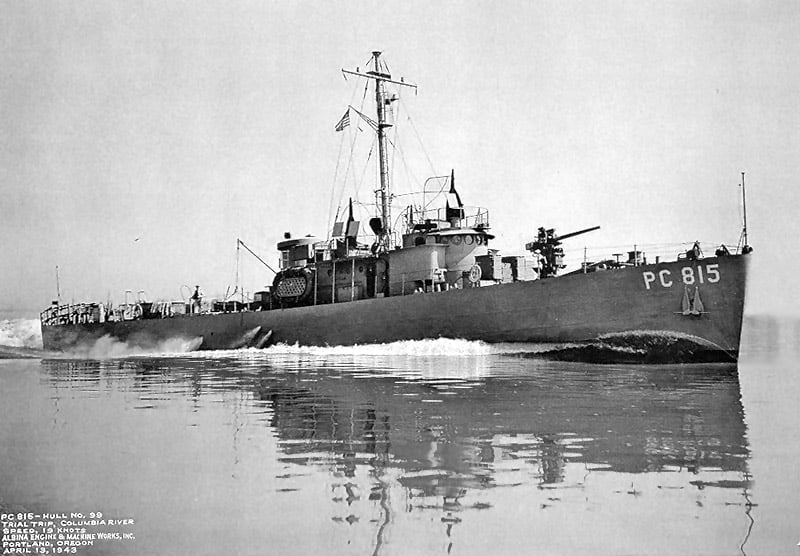
PC-815 running trials on the Columbia River in Oregon, 1943. US Navy Photo
Commissioned in 1943, PC-815 would go on to earn the name “The Jinxed Sub-Chaser”. Lt (j.g.) L. Ron Hubbard (the future founder of Scientology) was the first man to take the helm, only to be relieved of command three months later following a series of embarrassing incidents (including the shelling of Mexican territory) that caused his superiors to lose faith in his ability. The next few years were uneventful for the PC-815 until Sept. 11, 1945, when it collided with the destroyer USS Laffey (DD-724), burst into flames and sank.
A letter to the VA was written on October 15, 1947. It’s a man determined for psychological assistance that, reportedly, he by no means received.
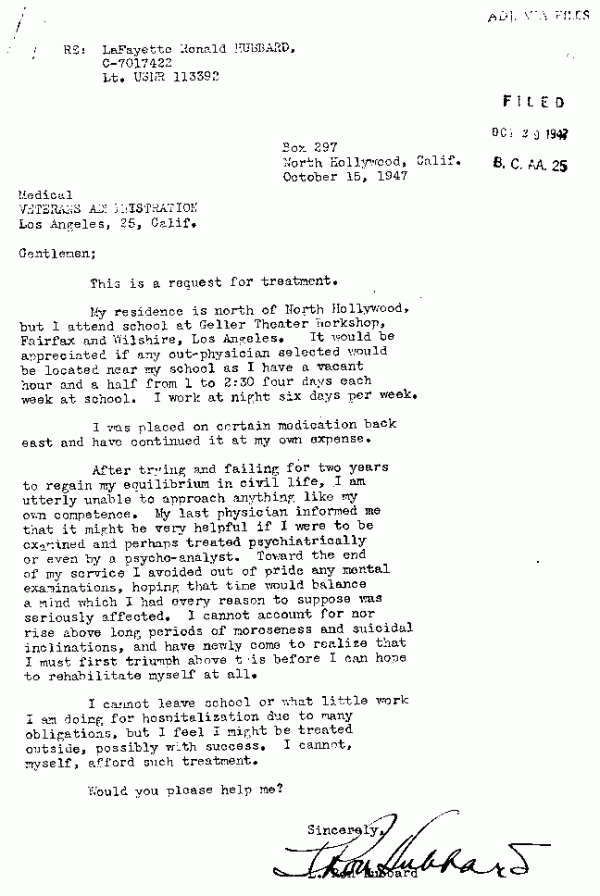
Somehow, as history notes as an event of galactic irony, he began writing a book teaching people how to obtain the very mental guidance and instruction he was so unfortunately denied.
Scientology has employed one of the most incredible defense tactics used by Allied convoys throughout the Battle of the Atlantic … The Zig-Zag Clock. Zig-zagging – the practice of frequently altering direction to port or starboard – was designed to disguise a convoy’s true course and confuse the enemy.
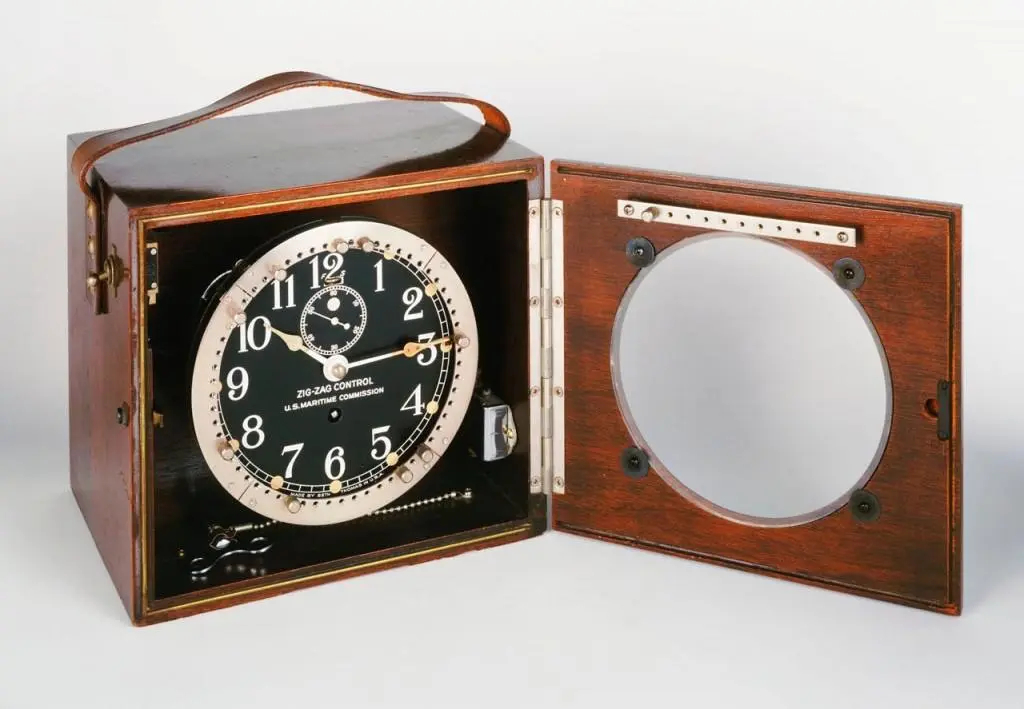
U.S. Maritime Commission Zig-Zag Control Clock, circa 1942-1950 ZAA0190
Jeff Wasel, Ph. D., Debunking Military Lies.
Part 1: Hubbard’s Tales from the South Pacific.
For the most part, Hubbard served his country honorably in a time of war; it’s his exploiting his time in the Navy to further Scientology, as well as embellishing his service record, personal decorations, and overall contribution to the war effort that I find repellent.
Part 2: Hubbard’s Australian Idyll.
The record shows that he volunteered to serve his country in a time of war, was deployed to combat theatre, and once there, could have made a contribution. Yet this reality wasn’t enough for Hubbard, and he would go on to exaggerate and lie about his Pacific service for many more years.
Part 3: Hubbard Fibs His Way Home.
What emerges from my work is a hybrid narrative that like many of Hubbard’s stories, narratives and anecdotes, reflects some truth among the many lies. This particular series of events is important in Hubbard’s mythology. By debunking the veracity of Hubbard’s tale here, we are also debunking the very foundations of Scientology. Like his fanciful narrative of espionage on Java and saving Australia, his homeward-bound odyssey reflects his hubris and predisposition to constantly exceed his authority. More sinisterly, it shows his selfishness and cowardice, as in falsifying orders to return home from Honolulu via air, he undoubtedly bumped a more deserving fellow serviceman, or worse, a military dependent or other, more worthy passenger, as well as avoiding a potentially hazardous journey by ship.
Part 4: Hubbard’s Fibs and Follies Afloat.
In Part Four, we turn to Hubbard’s brief time as a cable censor, his disastrous first attempt at command, and his eventual admission to the Submarine Chaser Training Center (SCTC) in Florida. We’ll look at Hubbard’s record as associated with the converted fishing trawler Mist, eventually recommissioned as the coastal patrol craft USS YP-442, as well as the Church of Scientology’s claims about his combat record in the Battle of the Atlantic. I’d like to once again thank Chris Owen in particular for his previous research, which was invaluable to me in providing much of the historical context for this post.
Part 5: The Not So Great “Battle of Cape Lookout”.
The events here cross the line from normal incompetence to a Walter Mitty-like delusional fantasy, where, in the space of 55 hours at the helm of the USS PC-815, Hubbard attacked two Japanese submarines that existed only in his imagination. The narratives that emerge from this event provide a powerful foreshadowing of Hubbard’s pattern of lies, self-aggrandizing fantasy, and fraudulent conduct that would define so much of his later life, especially in regard to his military service.
And, as we usually say here at PseudoScientology…

